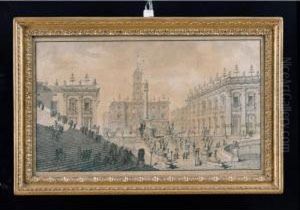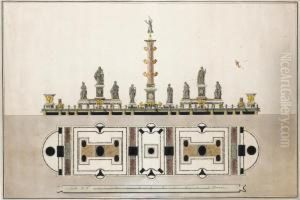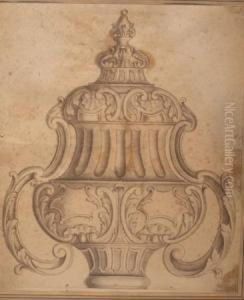Giuseppe Valadier Paintings
Giuseppe Valadier was an Italian architect and designer, born in Rome on April 14, 1762, to a French father, Luigi Valadier, who was a renowned silversmith. His father's influence and connections in the world of art and architecture helped Giuseppe develop an interest in the field from a young age. Valadier was not only an architect but also an urban planner, archaeologist, and a gold and silversmith like his father. He was a prominent figure in the neoclassical movement that was sweeping through Europe at the time, known for his refined designs that combined classical ideals with modern techniques.
Valadier's education in architecture began at the Accademia di San Luca in Rome, where he was influenced by the likes of Piranesi and Winckelmann, who were proponents of classical antiquity. His talents were recognized early in his career, and he was commissioned for numerous projects. One of his most notable works is the restoration of the Piazza del Popolo in Rome, which he transformed into one of the city's grandest urban spaces. Valadier designed the neoclassical façade of Santa Maria in Montesanto and Santa Maria dei Miracoli, as well as the layout of the piazza itself, including the exedrae framing the ancient Egyptian obelisk.
Beyond his work in urban planning, Valadier was also entrusted with the restoration of various ancient Roman monuments. This included work on the Arch of Titus and the Colosseum. He sought to preserve the authenticity of these structures while making them more comprehensible to contemporary viewers. His interventions were often sympathetic to the original, although they would not meet the strict standards of today's conservation practices.
Valadier's contributions to art and architecture were not limited to public and monumental works. He also designed and created exquisite pieces of decorative art, including silverware and furnishings that were sought after by the elite of his time. His work in this field showcased his versatility and his ability to bridge the gap between art and craftsmanship.
Giuseppe Valadier's impact on the Roman landscape was significant, and his works still contribute to the city's character today. He served as the architect of the Papal States, which positioned him as a key figure in shaping the architectural narrative of the Vatican and its surroundings during his lifetime. He passed away on February 1, 1839, in Rome, leaving behind a legacy that is etched into the very stones of the Eternal City. His works remain a testament to the enduring appeal of classical forms reinterpreted through the lens of the neoclassical style.


